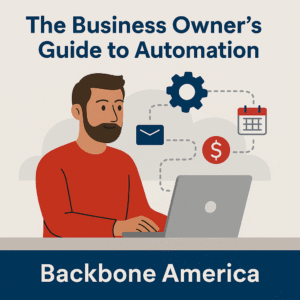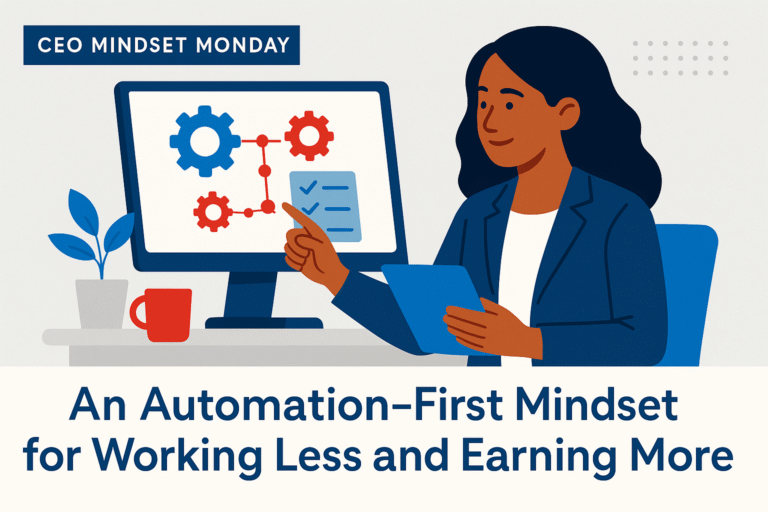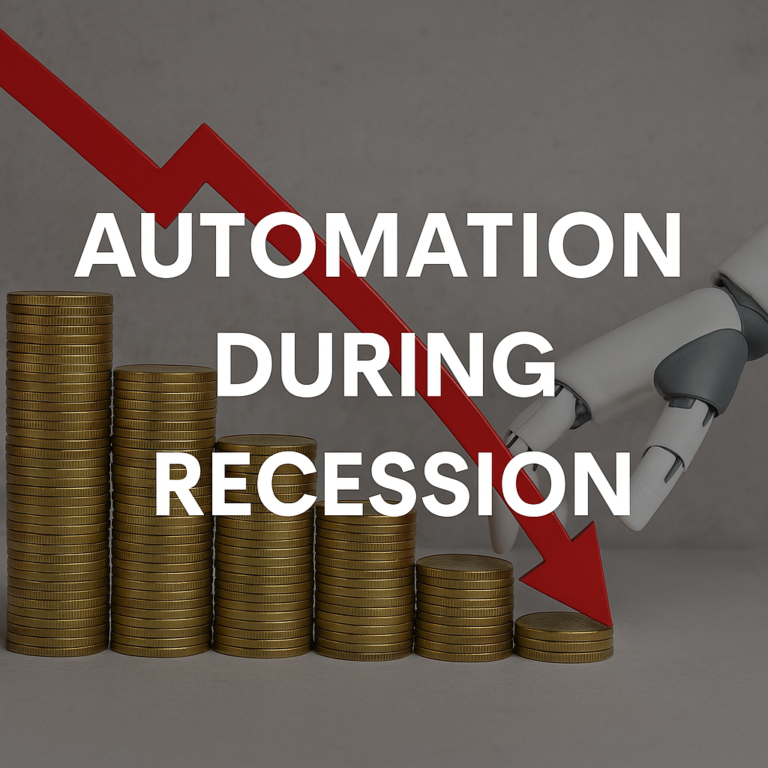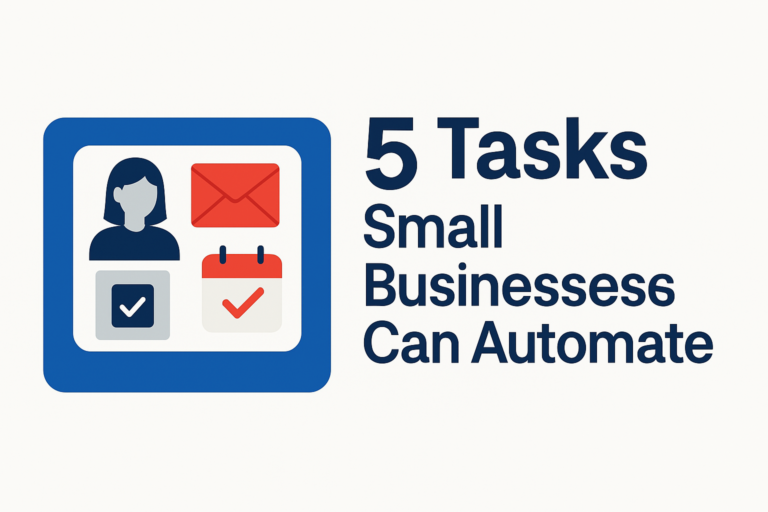Workflow Wednesday
Have you ever told yourself you’ll get to automation later—once things calm down, once you figure out your systems, once you have “more time”? If so, you’re not alone. For a lot entrepreneurs, waiting until there’s more time to build a better foundation is the default mode. But here’s the thing: a well-designed business automation workflow isn’t something you earn after success—it’s something you need to build it.
I’ve watched too many smart, capable people stay stuck in manual mode—not because they didn’t have the tools, but because they believed misinformation about what automation really is. Sometimes it was fear of getting it wrong. Sometimes it was the idea that only “real” businesses needed—or could afford—systems. And more often than not, it was just overwhelm disguised as logic.
If you’re building a business on the side—or running one that still depends heavily on your hands-on attention—this post is for you. Let’s break down the most common myths I’ve heard about automation and finally clear the path for the freedom and focus you’ve been working toward.
Myth #1: “Automation is for experts.”

But that’s the thing—I’ve worked with automation as a Business Process Automation Engineer. I’ve built out advanced systems, mapped out logic flows, and even done some light coding. And I can tell you this: most of the time, you don’t need expert skills—you just need clarity.
What makes a business automation workflow powerful isn’t how technical it is. It’s how clearly it reflects your process. If you can say, “When someone fills out this form, I want to send them this email and notify myself,” then you already know enough to build a basic workflow. Platforms like Zapier, Zoho CRM, and even Google Forms with integrations are built for exactly that kind of logic. The barrier isn’t knowledge—it’s confidence.
So no, automation isn’t reserved for developers or agencies. It’s for entrepreneurs who are tired of losing hours on tasks that could be handled in the background. If you’re reading this, you’re capable. And if you need a little structure to get started, I created The Business Owner’s Guide to Automation for exactly that reason.
Myth #2: “I need everything mapped out first.”

But here’s what I’ve learned: a business automation workflow isn’t the last step in building your business—it’s part of how you figure things out.
I’ve mapped out hundreds of workflows. And honestly? Some of my clearest insights came after I started automating. The gaps became obvious once I saw what was slowing me down. For example, when I automated parts of my follow-up process, I realized half the people I was attracting weren’t actually ready to buy. That insight didn’t come from strategy sessions—it came from watching the data once my system was in motion.
You don’t need a perfect blueprint. You need a starting point. Automate what you know now. Then improve it as you go. Most platforms make it easy to tweak your steps without tearing everything down. What matters is forward movement.
Waiting until you have it all figured out might sound smart. But in practice? It’s usually just a slower path to clarity.
Myth #3: “Automation makes business feel cold.”
This one comes up more often than you’d think. People worry that once you automate something, it loses its heart. That it becomes robotic, distant, transactional. And I get where that concern comes from—but here’s where I stand: automation isn’t what makes business feel cold. Inefficiency is.
I’ve never been someone who wanted to work harder than necessary. I’m 49, and I’ve been thinking in systems since my first programming class back in 1999. One of my earliest assignments was to print the same line of text over and over. Most people followed the instructions literally.
I paused. There had to be a better way. I read ahead, found how to write a loop, and never looked back.
Even now, in 2025, that instinct drives everything I build: how do we do this smarter? How do we reduce friction, not increase it in the name of “personal touch”?
Because here’s what I know: when your systems are thoughtful, you create more consistency—not less care. Your emails get sent. Your leads get followed up with. And your client gets a timely welcome message instead of waiting two days for you to catch your breath.
Automation isn’t cold. It’s clarity. It’s intention. And when automation aligns with your voice and values, it actually creates more space to be human—just not at your own expense.
Myth #4: “It’s too early to automate.”
This one’s sneaky because it sounds strategic. You hear it in phrases like “I’m not ready yet” or “I don’t want to automate the wrong thing.” But behind that logic is often fear. Fear of getting it wrong. Fear of wasting time. Fear of committing to something that might change.
But here’s what I’ve seen: delaying automation because you’re still “figuring things out” usually means staying stuck longer than necessary.

When I first launched Backbone America, I didn’t wait to automate. Even before I had traction, I set up systems for intake, delivery, and follow-up. Not because everything was perfect—but because I knew I needed a solid foundation if things did work. I’ve seen what happens when entrepreneurs finally get momentum… and then crash under the weight of doing it all manually. By the time they try to systematize, they’re exhausted or discouraged—or worse, burned out from trying to serve people without the backend to support it.
Here’s the truth: automation doesn’t assume you’ve arrived—it prepares you to keep going. Even simple steps—like triggering a thank-you email after a form submission or adding leads to a CRM—can make your business feel more grounded and real.
So no, it’s not too early. If you have an offer, a lead magnet, or a single process you repeat more than once… it’s time.
What These Myths Cost Us
These myths don’t just waste time—they quietly erode your confidence. The real cost of avoiding a business automation workflow isn’t just inefficiency. It’s hesitation. When your back-end is scattered, everything feels harder. You question your capacity. You hold back on taking new clients or launching new offers—not because you’re not ready, but because your systems aren’t.
That was me in the early days of Backbone America. Before I ever became an automation engineer, I met with a marketing agency to explore what it would take to grow. The quote he gave me just to get started was staggering—thousands I didn’t have. I told him I couldn’t afford it. And he said, flat out: “The business this budget brings in will more than cover the cost.”
Then he mentioned his daughter was putting together a DIY course that might be more affordable… but it would take more time, more effort, and more work I didn’t have. I was already doing everything manually. I couldn’t keep up as it was.
And even if I had found the money, I realized something deeper: I couldn’t handle the kind of business he was proposing. It was just me—coaching, consulting, managing every detail. No intake process. No delivery workflows. No CRM. I wasn’t scared of growth—I was unprepared for it.
That moment stuck with me. Because the truth is, a surge in sales can sink a business that isn’t ready. Automation isn’t just about saving time. It’s about protecting your capacity, your energy, and your reputation when success starts showing up.
You don’t need to automate everything. Just start somewhere.

Inside The Business Owner’s Guide to Automation, I walk you through five simple systems to help you save time and increase profits—without hiring a team or becoming a tech expert. Whether you’re managing client onboarding, payments, emails, or social media, this guide shows you how to create a business that runs smoother… even if you’re still doing most things yourself.






